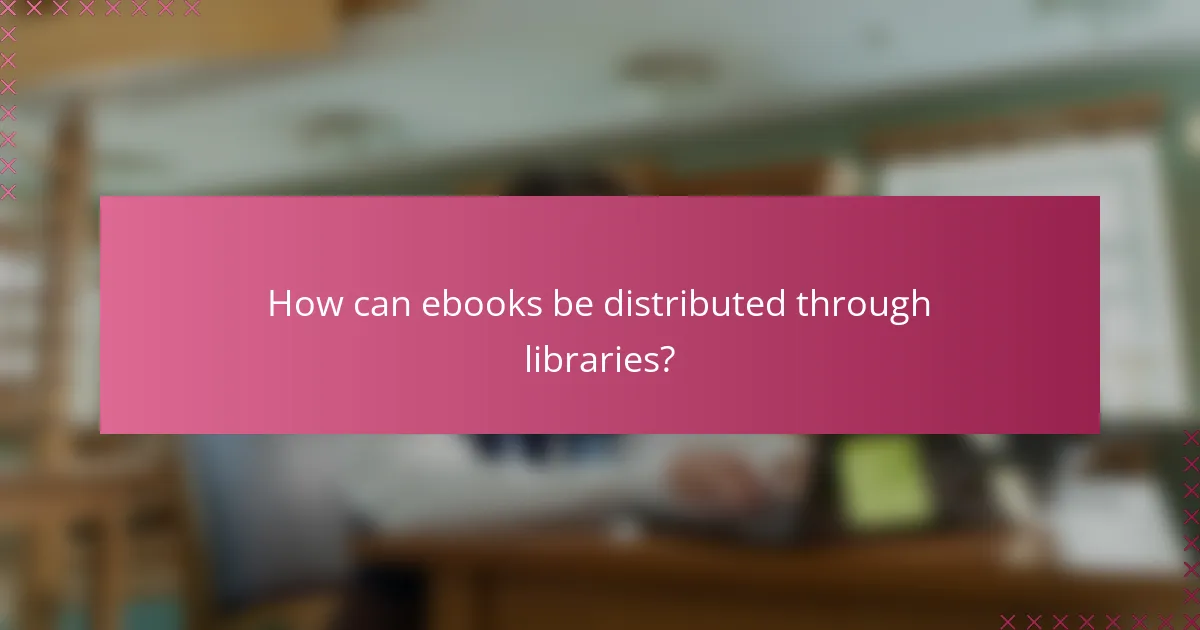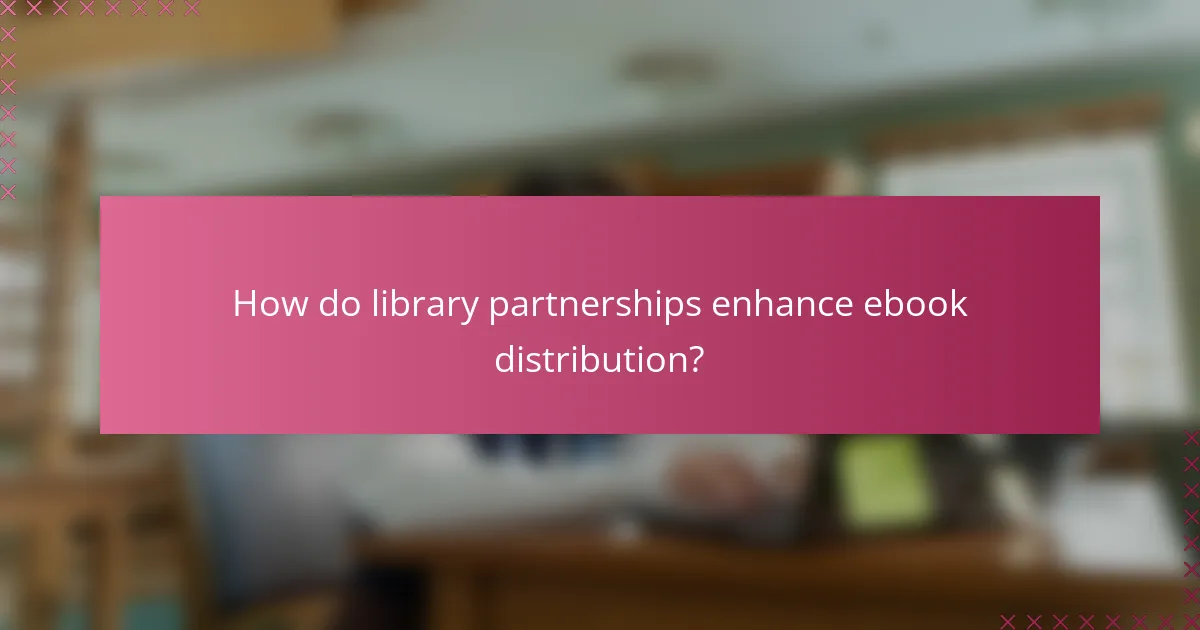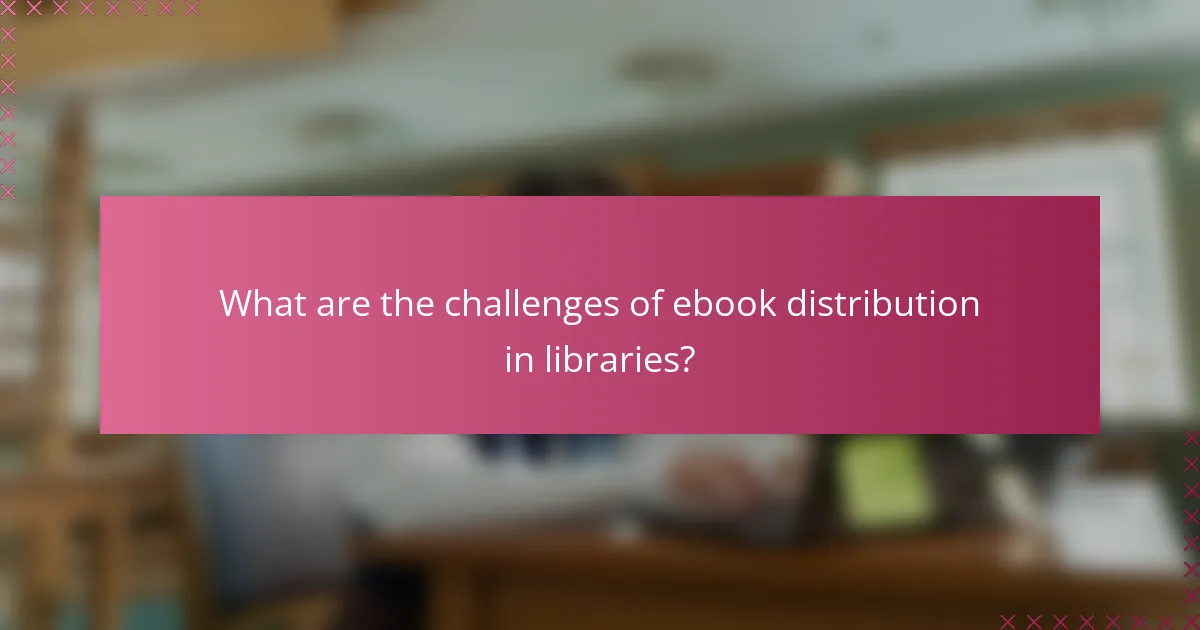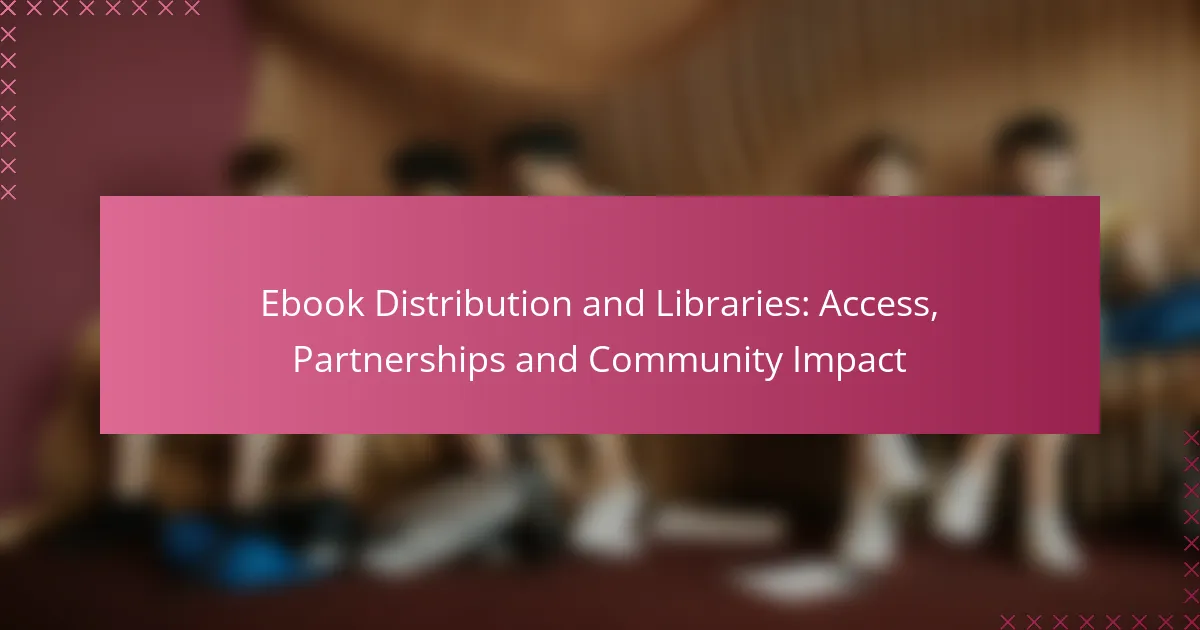Ebook distribution through libraries plays a crucial role in enhancing access to literature for diverse communities. By forming partnerships with publishers and utilizing digital platforms, libraries can overcome licensing challenges and offer a vast array of titles. This not only improves availability but also ensures that reading materials are accessible to all, fostering a more inclusive literary environment.

How can ebooks be distributed through libraries?
Ebooks can be distributed through libraries via various methods, including partnerships with publishers, consortium agreements, and digital platforms. These approaches enable libraries to provide patrons with access to a wide range of digital titles while navigating licensing and distribution challenges.
Direct partnerships with publishers
Libraries can establish direct partnerships with publishers to acquire ebooks for their collections. This often involves negotiating terms that allow libraries to lend digital titles under specific conditions, such as limited access periods or simultaneous use licenses. Such partnerships can enhance the selection of available titles and ensure that popular books are accessible to patrons.
When forming these partnerships, libraries should consider factors like pricing models, renewal terms, and the potential for exclusive content. Building strong relationships with publishers can lead to better deals and access to new releases.
Library consortium agreements
Library consortia are groups of libraries that collaborate to share resources, including ebooks. By pooling their budgets and negotiating collectively, consortia can secure better pricing and licensing terms from publishers. This approach allows smaller libraries to access a broader range of digital content than they could individually afford.
Joining a consortium can also streamline the acquisition process, as libraries can benefit from shared cataloging and circulation systems. Libraries should evaluate the consortium’s structure and the specific benefits it offers to ensure alignment with their goals.
Digital platforms like OverDrive
Digital platforms such as OverDrive facilitate ebook lending by providing libraries with access to a vast catalog of titles. These platforms manage the licensing and distribution, allowing libraries to focus on serving their patrons. Users can borrow ebooks through their library’s website or app, making it convenient to access materials.
Libraries should assess the platform’s fees, available titles, and user interface to ensure it meets their needs. Regularly reviewing usage statistics can help libraries optimize their collections and make informed purchasing decisions.
Self-publishing options
Self-publishing allows authors to distribute their ebooks directly to libraries, bypassing traditional publishing routes. Libraries can acquire these titles through platforms that specialize in self-published works, expanding their collections with unique and diverse content. This method can also support local authors and promote community engagement.
Libraries should establish clear guidelines for evaluating self-published titles, including quality standards and relevance to their patrons. Engaging with local authors can foster partnerships and enhance the library’s role in the community.
Subscription models for libraries
Subscription models enable libraries to access a rotating selection of ebooks for a fixed fee. This approach allows libraries to offer a wide variety of titles without the upfront costs associated with purchasing individual licenses. Subscription services often include popular and trending titles, appealing to a broad audience.
When considering subscription models, libraries should evaluate the cost-effectiveness and the range of titles offered. It’s important to assess how often the content is updated and whether the subscription aligns with the library’s collection development goals.

What are the benefits of ebook access in libraries?
Ebook access in libraries offers numerous advantages, including enhanced availability of reading materials and improved accessibility for diverse populations. Libraries can provide a wider range of titles without the physical limitations of traditional books, making literature more reachable for everyone.
Increased readership and accessibility
Ebooks significantly boost readership by allowing patrons to access a vast collection of titles from anywhere, at any time. This convenience encourages more people to engage with literature, particularly those who may have mobility challenges or live in remote areas.
Additionally, many ebook platforms offer features like adjustable font sizes and text-to-speech options, catering to individuals with visual impairments or learning disabilities. Such enhancements ensure that libraries can serve a broader audience effectively.
Cost-effective resource for libraries
Ebooks can be a cost-effective resource for libraries, as they often require lower upfront investment compared to physical books. Libraries can save on storage space, maintenance, and replacement costs associated with damaged or lost physical copies.
Moreover, many ebook licensing models allow libraries to purchase titles based on demand, which can lead to more efficient use of budgetary resources. This flexibility enables libraries to adapt their collections to the interests of their communities without overspending.
Support for diverse communities
Ebook access supports diverse communities by providing a wide array of titles that reflect various cultures, languages, and perspectives. Libraries can curate collections that resonate with the unique demographics of their service areas, fostering inclusivity.
Furthermore, digital formats allow libraries to offer materials in multiple languages, catering to non-native speakers and promoting literacy across different populations. This commitment to diversity enhances community engagement and strengthens the library’s role as a vital resource for all residents.

How do library partnerships enhance ebook distribution?
Library partnerships significantly enhance ebook distribution by combining resources, expertise, and outreach efforts. These collaborations allow libraries to provide broader access to digital content, benefiting both patrons and publishers.
Collaborative marketing efforts
Collaborative marketing efforts between libraries and ebook distributors can amplify visibility and engagement. By jointly promoting new titles through newsletters, social media, and community events, libraries can attract more readers and increase circulation rates.
For instance, a library might partner with a local author to host a virtual book launch, leveraging both the library’s platform and the author’s audience. This synergy can lead to higher ebook checkouts and foster a sense of community around reading.
Shared resources and funding
Shared resources and funding are crucial for expanding ebook collections without straining budgets. Libraries can pool financial resources to negotiate better licensing agreements with publishers, making a wider range of titles available to their patrons.
For example, multiple libraries in a region might collaborate to fund a shared subscription service, allowing access to a larger catalog of ebooks while reducing individual costs. This approach maximizes the impact of limited budgets and enhances the overall quality of library offerings.
Access to wider audiences
Partnerships enable libraries to reach wider audiences, including underserved communities. By collaborating with schools, community organizations, and local businesses, libraries can promote their ebook collections to diverse groups, ensuring that more individuals have access to digital reading materials.
Additionally, libraries can utilize data from partnerships to identify gaps in service and tailor their collections to meet the specific needs of different demographics. This targeted approach not only increases usage but also strengthens community ties and promotes literacy.

What are the challenges of ebook distribution in libraries?
Ebook distribution in libraries faces several significant challenges, including licensing complexities, budget limitations, and technology barriers for users. These factors can hinder access to digital content and impact the overall effectiveness of library services.
Licensing and copyright issues
Licensing and copyright issues are central challenges in ebook distribution for libraries. Publishers often impose restrictive licensing agreements that limit the number of simultaneous users or require libraries to purchase multiple copies for high-demand titles. This can lead to increased costs and complicate the management of digital collections.
Additionally, copyright laws vary by country, affecting how libraries can lend ebooks. For instance, in the European Union, libraries must navigate specific regulations that govern digital lending, which can differ significantly from those in the United States.
Budget constraints for libraries
Many libraries operate under tight budget constraints, which can severely limit their ability to acquire ebooks. With funding often allocated to physical materials and other essential services, libraries may struggle to justify the expense of digital collections, especially when prices for ebooks can be significantly higher than print versions.
Libraries must prioritize their spending, often leading to tough decisions about which titles to purchase. This can result in gaps in available content, particularly for popular or newly released ebooks, which may not be accessible to patrons.
Technology barriers for users
Technology barriers can impede users’ access to ebooks in libraries. Not all patrons may have the necessary devices or internet access to download and read digital materials, particularly in underserved communities. This digital divide can limit the reach of library services and exclude certain demographics from benefiting from ebook offerings.
Moreover, the platforms used for lending ebooks can be complex and may require users to navigate various apps or software. Libraries need to provide adequate support and training to help patrons overcome these technological hurdles and fully utilize available resources.

How do ebooks impact community engagement?
Ebooks significantly enhance community engagement by providing accessible resources that foster learning and connection. They allow libraries to reach diverse populations, offering a wider range of materials that cater to various interests and needs.
Programs promoting digital literacy
Digital literacy programs are essential for equipping community members with the skills needed to navigate ebooks and digital platforms. These programs often include training sessions that cover basic technology use, online research skills, and ebook navigation.
For example, libraries may offer workshops that teach participants how to download and read ebooks on different devices. Such initiatives can increase overall digital proficiency, making it easier for residents to access information and educational resources.
Events and workshops for users
Events and workshops centered around ebooks can create opportunities for community members to engage with literature and technology. Libraries often host author readings, book clubs, and themed discussions that focus on popular ebooks, fostering a sense of community among participants.
Additionally, hands-on workshops can guide users through the process of borrowing ebooks, using library apps, and exploring new genres. These events not only promote reading but also encourage social interaction and collaboration among attendees.
Partnerships with local organizations
Collaborating with local organizations can amplify the impact of ebook initiatives in the community. Libraries can partner with schools, non-profits, and businesses to create programs that promote ebook access and literacy.
For instance, a library might work with a local school to provide students with access to educational ebooks, enhancing their learning experience. Such partnerships can also help libraries reach underserved populations, ensuring that everyone has the opportunity to benefit from digital resources.
